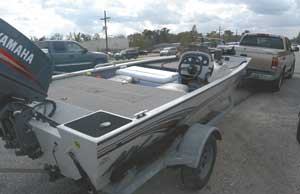
The annual breeding dance is beginning at Tensas River National Wildlife Refuge. Will you be there for the party?
In the September issue of Louisiana Sportsman, I wrote about trailer bearing failures and how to avoid them.A recent e-mail I received asked for my opinion on a different type of trailer bearing lubrication system that was not mentioned in that article. That system is referred to as oil bath trailer hubs. Some people claim they are the greatest thing since sliced bread. I’m not 100 percent sure of that. These hubs are relatively new to the boating market, and I would like to see more road time to determine how they’ll hold up in the long run.
The oil bath system is quite simple. Instead of packing the wheel bearings with grease, the hubs are filled with oil. In theory, this gives better lubrication to the bearing because the oil is liquid and will flow over and around each and every bearing needle.
This is accomplished by replacing the bearing protector device on the outside of the hub with a clear plastic sealed cup. The grease seal in the rear of the hub is also replaced with a stronger seal to hold in the oil. There is a small fill hole in the front of the hub that allows you to fill it with oil and then seal it with a plug.
It sounds like a great idea, but will it hold up?
The majority of the bearing failures that I see in my shop are not because of a lack of lubrication but primarily due to a lack of maintenance. Trailer bearing hubs should be removed at least once every two years, and the bearings should be cleaned and inspected.
If the bearings are not damaged, they can be repacked with grease and used again. If there is any damage, it is rarely due to a breakdown in the lubricating qualities of the grease but a result of a seal failure that has allowed water into the hub.
The weak link in the greased hub is the seal, not the grease. When we trailer our boats, there is a lot of road dirt and grit that can accumulate around the rear of the hub where the seal is located. This grit becomes lodged between the seal and the trailer axle. The result is either a failed seal or sometimes a damaged axle. When the boater launches his boat at a backdown ramp, water can invade the hub, and a bearing failure is soon to follow.
My concern for the oil bath hub is the same as the greased hub. The hub seals are the weak link. If that seal is damaged for any reason, the oil will leak out of the hub, and a bearing failure is soon to follow.
The oil bath hubs have a clear plastic cover on the outside of the hub so that you can check the oil level and also inspect for water contamination. Sometimes these plastic hub caps will discolor with age, and you will no longer be able to see inside to inspect the oil. If this happens, you should immediately have the caps replaced so that you can properly monitor the condition and level of the oil.
You should ask yourself how willing are you to diligently check these caps for tell-tale signs of possible problems. I believe the oil bath is a better way of lubricating the bearings, but if it is not properly checked and maintained, it could have just as many failures as the packed grease bearing.
No matter what lubrication system you have on your trailer, it would be a good idea to have the hubs removed every two years. The seals can be replaced and the axle surface that the seals ride on should be cleaned and polished in order to maximize the seal’s ability to do its job.
One other thing you may want to do is to clean the back of your trailer hubs when you return home. While you are washing down your boat, you can take your garden hose and spray the rear of the hubs to help clean off some of that road dirt before it gets a chance to build up and cause trouble.
It takes a little more effort but I would much rather do that than be sitting on side of the road with a wheel bearing failure.
If you have any questions about your boat, motor or trailer, you can contact me via e-mail at hanktheboatdr@yahoo.com. You can also find complete contact information on my web site www.theboatdr.com.


